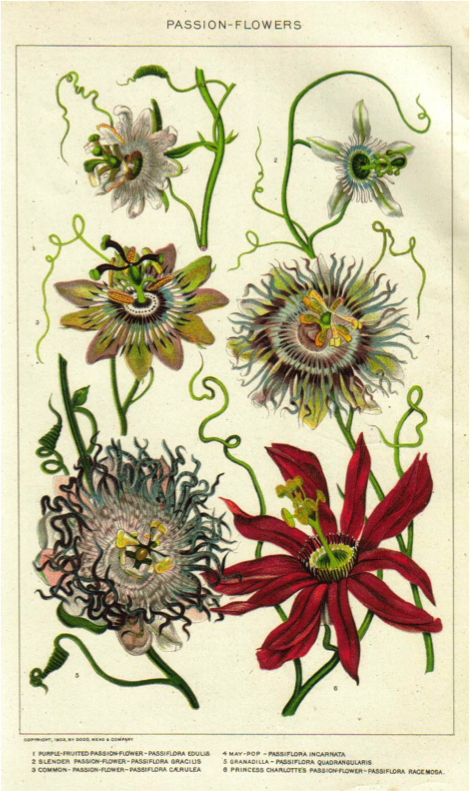Passiflora: Garden Charm and Beauty
If the sound of a whimsical, pollinator-seducing, pet-friendly, fruit-bearing vine is something you’ve just now decided you must have in your garden, look no further than the wonderful world of Passiflora!
 While there are more than 400 species of Passiflora, P. edulis (top left) will probably be your best bet in San Diego County. Also, the deciduous P. incarnata (top right), commonly known as maypop, is likely to do well in parts of the county that are susceptible to winter freezes.
While there are more than 400 species of Passiflora, P. edulis (top left) will probably be your best bet in San Diego County. Also, the deciduous P. incarnata (top right), commonly known as maypop, is likely to do well in parts of the county that are susceptible to winter freezes.
One thing to keep in mind with Passiflora’s spectacular other-worldly flowers is that they’re borne on vines that are always in a rush to grow long and far. Passionflower’s curly, yet no-nonsense, tentacles are wonderful anchors enabling the plant to quickly fill out a trellis, cover unsightly fences, or even scramble about as a carpet of groundcover. With some strategically placed wire for the vine to grip, you can also have a lush, prolific plant adorning an otherwise flat, ho-hum wall.
On the other hand, be ready to prune annually (preferably in late winter) once you’ve had your passionflower for three years or so. This will keep your vine looking healthy while ensuring that you don’t end up with a monster on your hands—and everywhere else on your property!
In addition to the spectacular blooms on most Passiflora species, you can enjoy seeing the curious kinky tendrils and indulge in the exotic, juicy summertime passion fruit. All of this bounty comes from a vine that I will surely live in when I return in my next life as a flittering faerie.
During this lifetime, though, one thing you can do to create a magical home for your garden faeries is be mindful that passionflower can only afford to be lavish with their gifts if they are well fed. You’ll want to give your vines some diluted, balanced fertilizer every other week beginning in late winter until new growth appears in early spring. This can be tapered off to once every month or every six weeks through the end of summer.
Similarly, passionflower vines are thirsty during the growing season and, depending on how hot and dry your garden is, they may need one or two deep waterings during this time. In the winter, you, and your Passiflora, will be happy to suspend the irrigation—unless there’s no rain at all, in which case a little sprinkle here and there will suffice.
Finally, despite the food and water suggestions, you may recall the fair warning that this plant will need to be kept in check with a good pair of pruners: Passiflora is beautiful, but not particularly fastidious, including when it comes to soil type. Any garden soil mix will do—something that drains well is preferable, but if your vine is otherwise happy with its new home, it will likely grant you some leniency in heavier soil. Also, you’ll be rewarded for maintaining up to three inches of mulch to keep the roots cool in the warmer months and moist year-round.
If you want to learn more about Passiflora and how to care for them, please visit UC Cooperative Extension, Ventura County’s Passion Fruit page.
This article was originally published in San Diego Floral’s “California Gardens” magazine January/February 2020
Marun is a UCCE Master Gardener

